Abstract
Werner syndrome (WS) is an autosomal recessive disease with a complex phenotype that is suggestive of accelerated aging. WS is caused by mutations in a gene, WRN, that encodes a predicted 1,432-amino-acid protein with homology to DNA and RNA helicases. Previous work identified four WS mutations in the 3' end of the gene, which resulted in predicted truncated protein products of 1,060-1,247 amino acids but did not disrupt the helicase domain region (amino acids 569-859). Here, additional WS subjects were screened for mutations, and the intron-exon structure of the gene was determined. A total of 35 exons were defined, with the coding sequences beginning in the second exon. Five new WS mutations were identified: two nonsense mutations at codons 369 and 889; a mutation at a splice-junction site, resulting in a predicted truncated protein of 760 amino acids; a 1-bp deletion causing a frameshift; and a predicted truncated protein of 391 amino acids. Another deletion is >15 kb of genomic DNA, including exons 19-23; the predicted protein is 1,186 amino acids long. Four of these new mutations either partially disrupt the helicase domain region or result in predicted protein products completely missing the helicase region. These results confirm that mutations in the WRN gene are responsible for WS. Also, the location of the mutations indicates that the presence or absence of the helicase domain does not influence the WS phenotype and suggests that WS is the result of complete loss of function of the WRN gene product.
Full text
PDF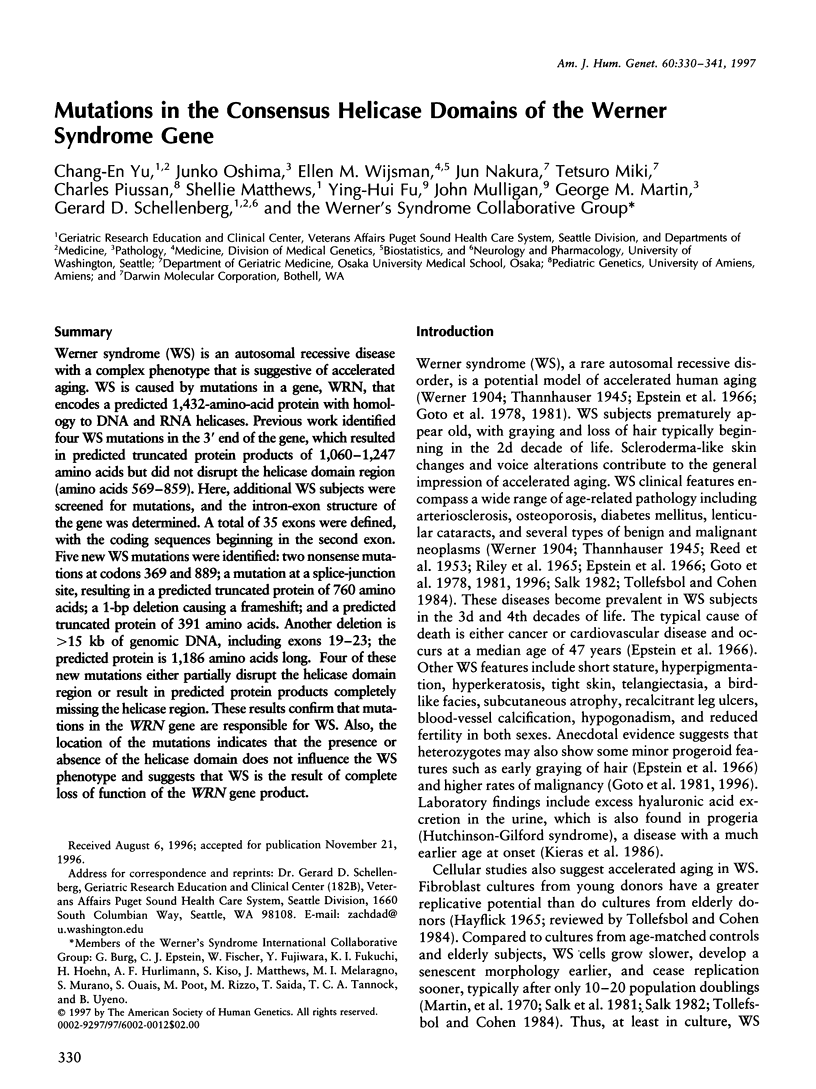
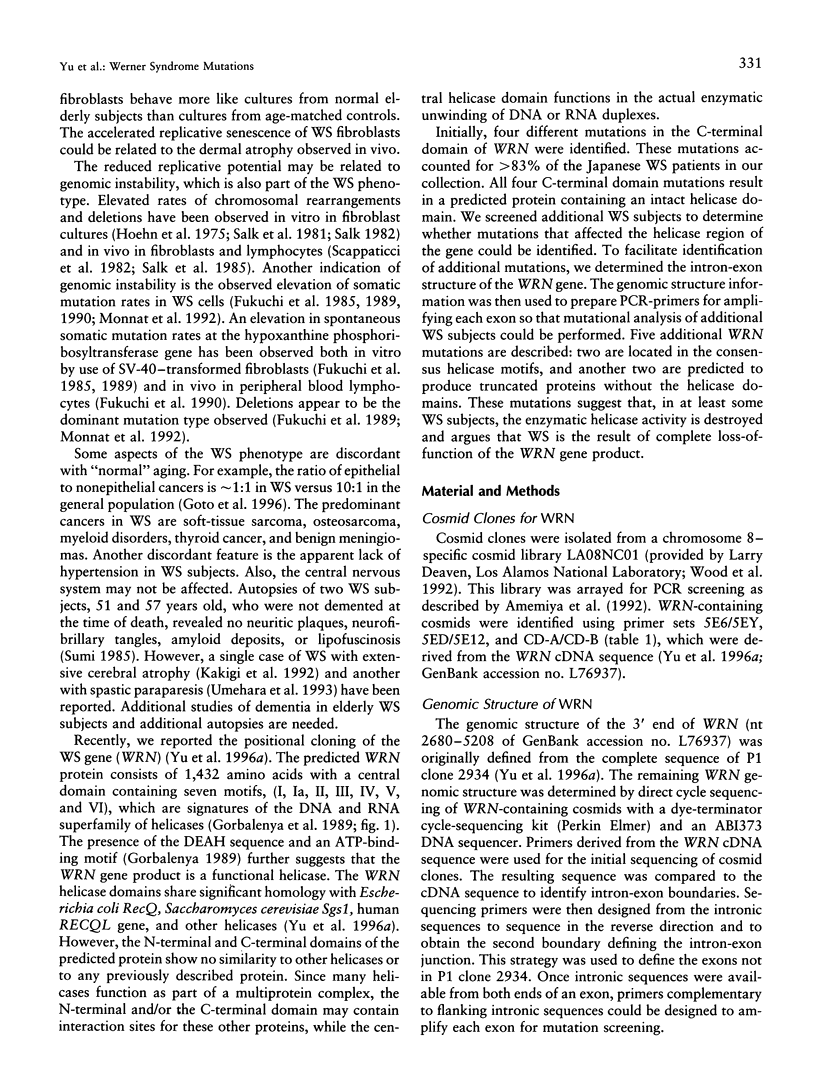
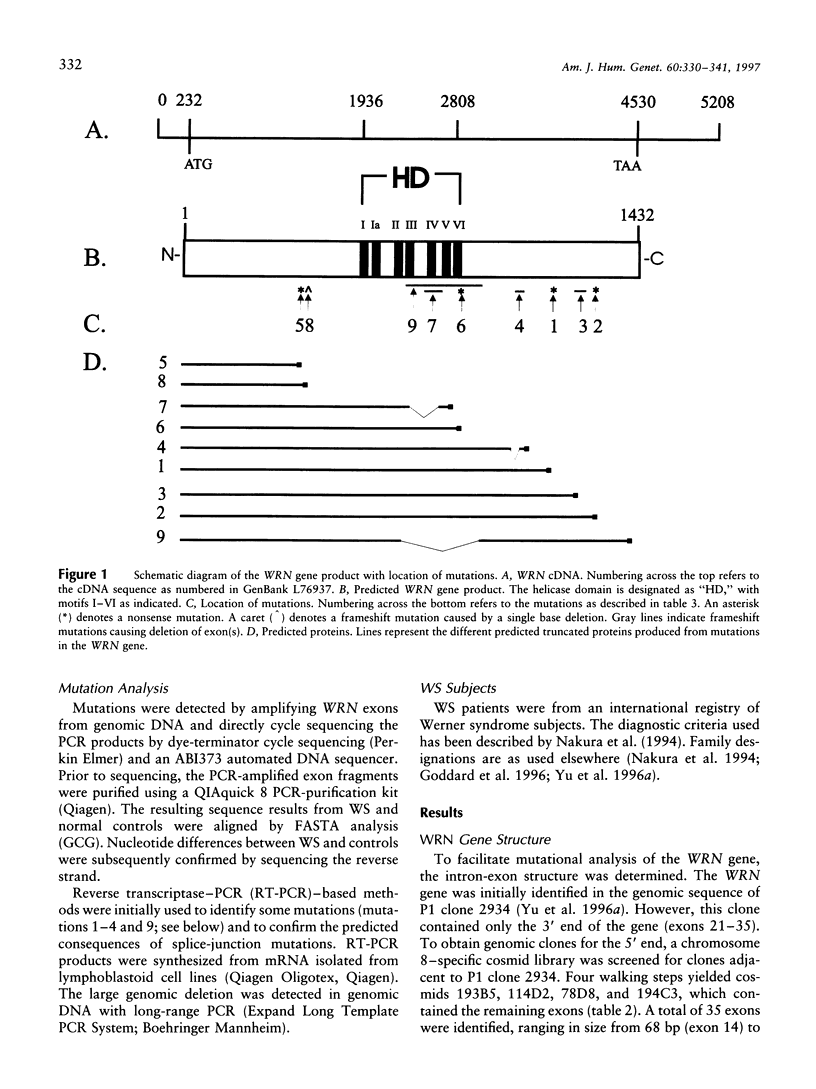
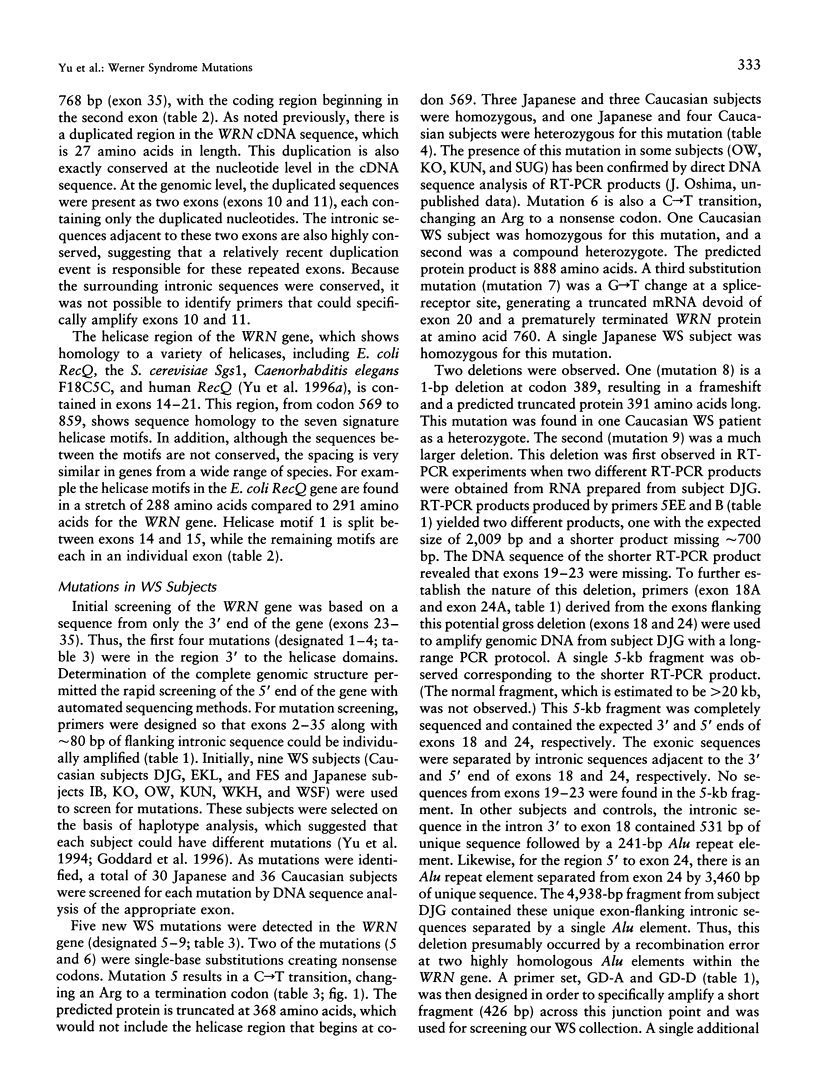


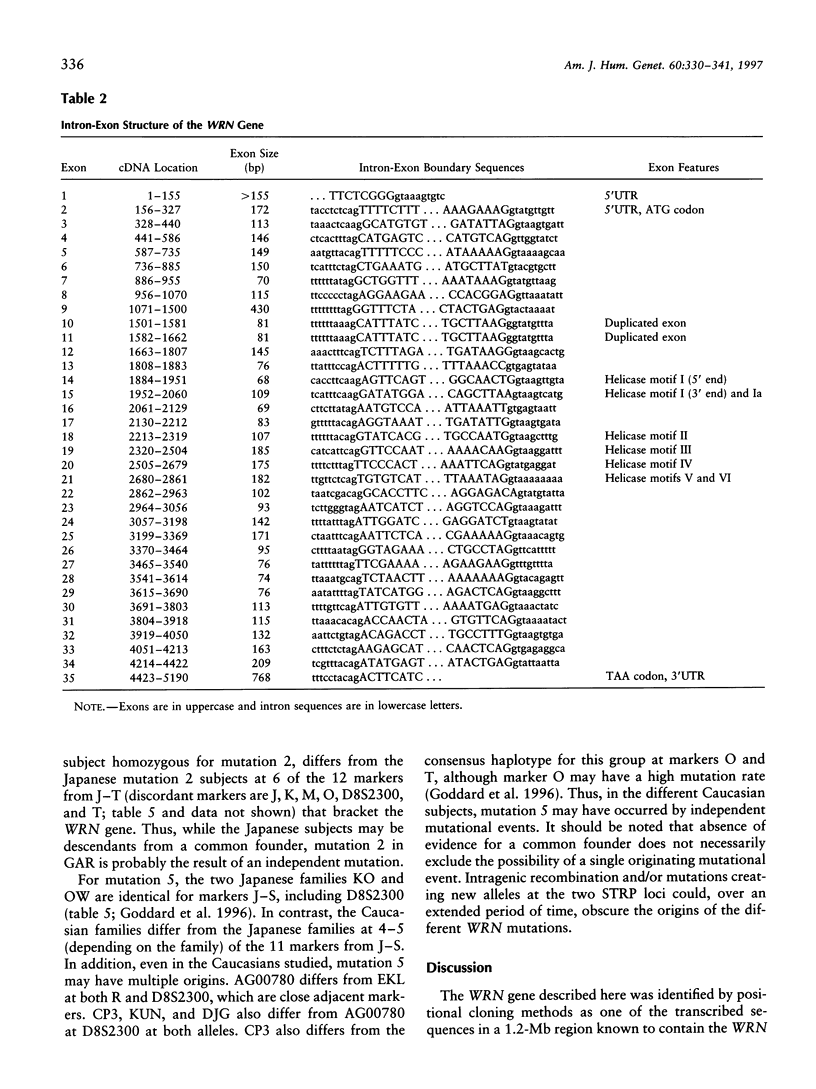
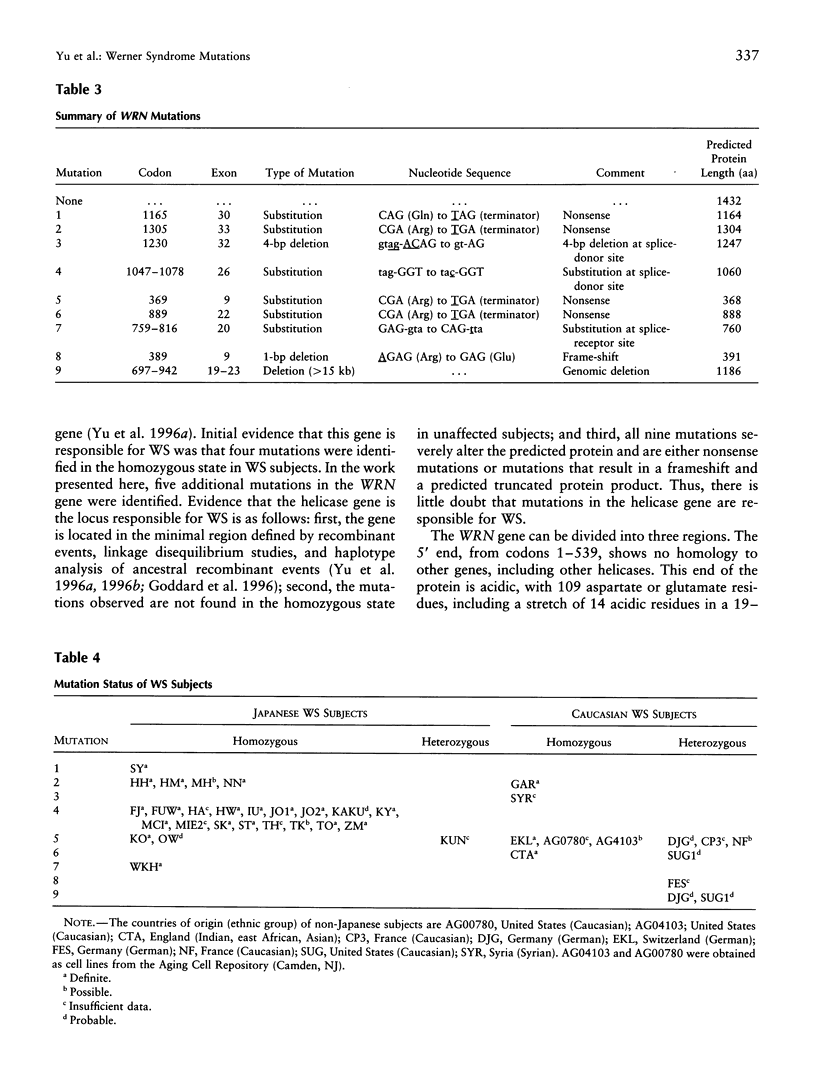
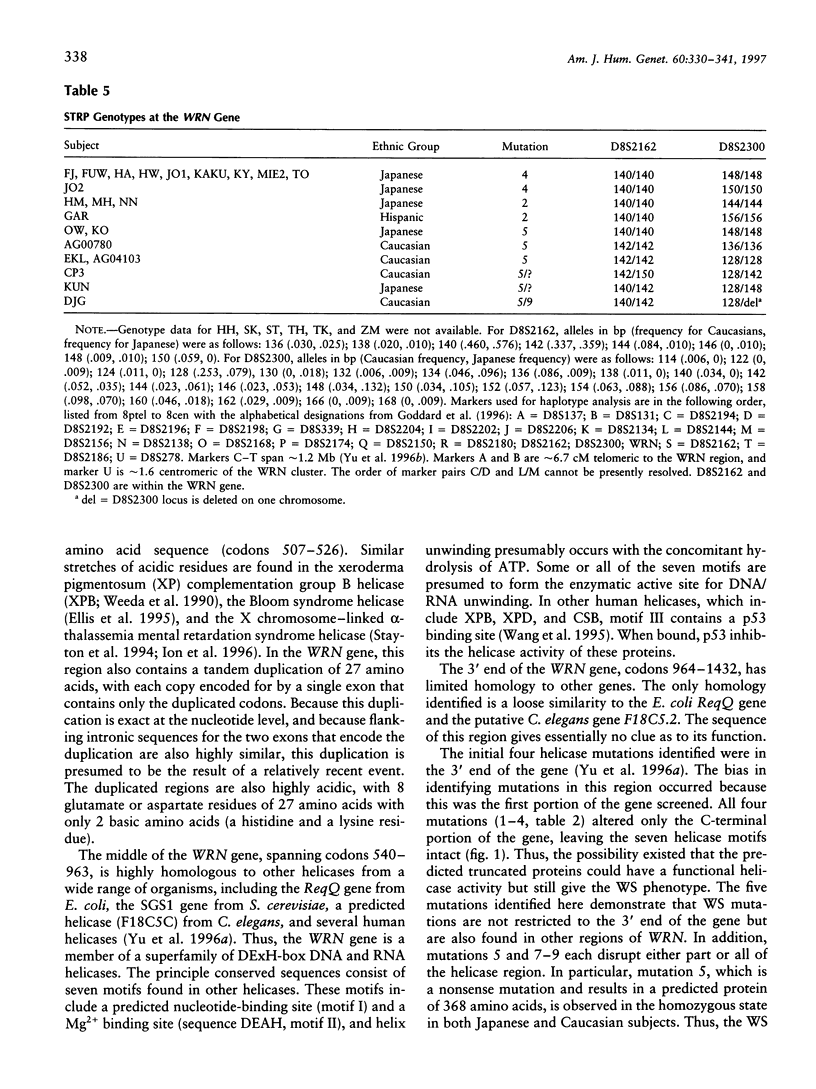
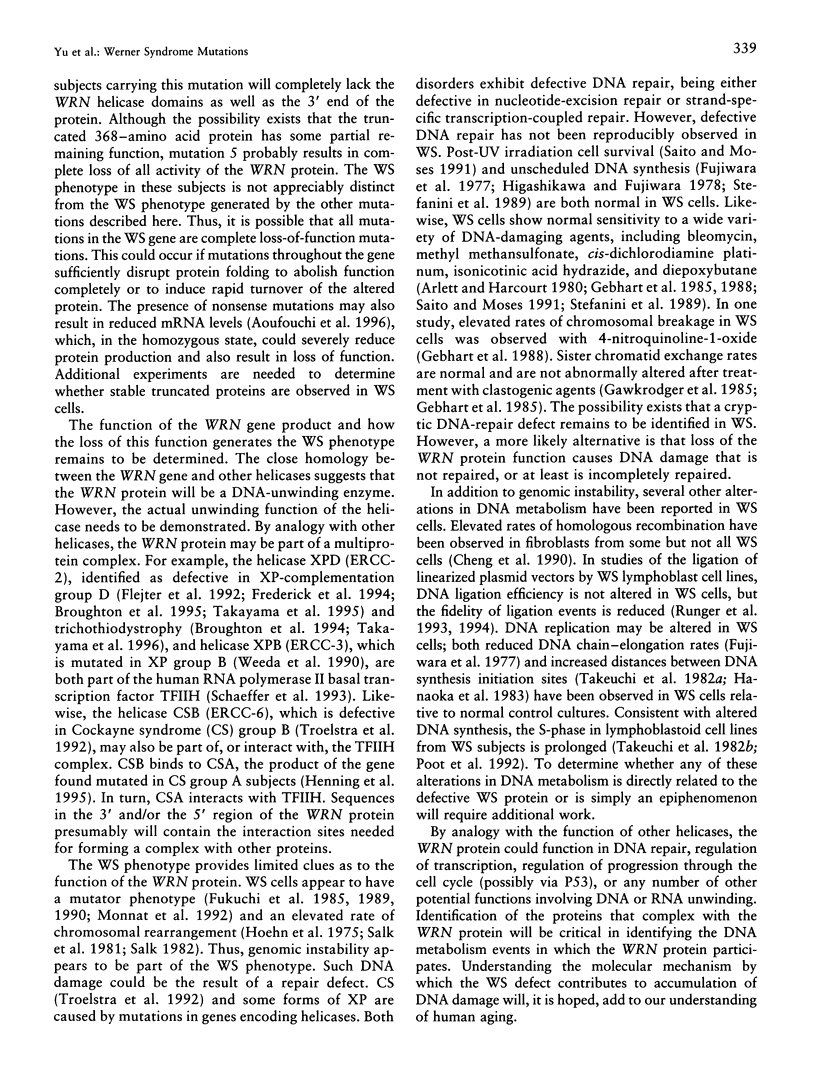
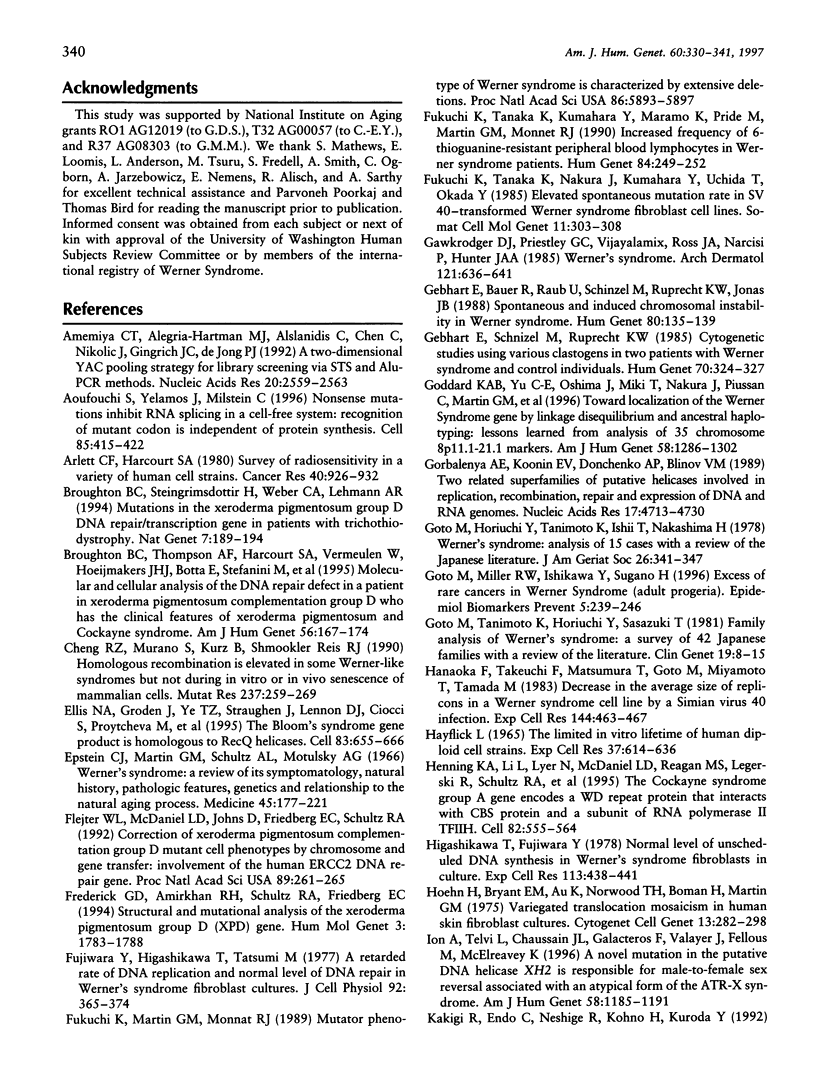
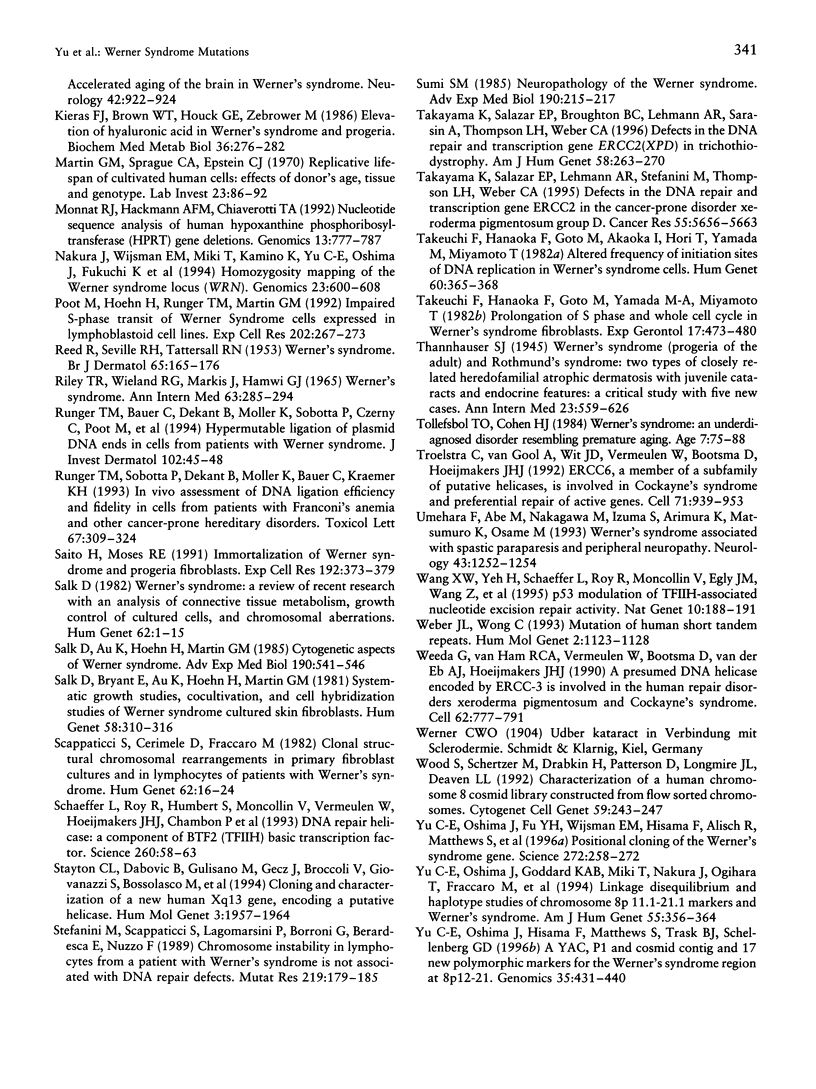
Selected References
These references are in PubMed. This may not be the complete list of references from this article.
- Amemiya C. T., Alegria-Hartman M. J., Aslanidis C., Chen C., Nikolic J., Gingrich J. C., de Jong P. J. A two-dimensional YAC pooling strategy for library screening via STS and Alu-PCR methods. Nucleic Acids Res. 1992 May 25;20(10):2559–2563. doi: 10.1093/nar/20.10.2559. [DOI] [PMC free article] [PubMed] [Google Scholar]
- Aoufouchi S., Yélamos J., Milstein C. Nonsense mutations inhibit RNA splicing in a cell-free system: recognition of mutant codon is independent of protein synthesis. Cell. 1996 May 3;85(3):415–422. doi: 10.1016/s0092-8674(00)81119-8. [DOI] [PubMed] [Google Scholar]
- Arlett C. F., Harcourt S. A. Survey of radiosensitivity in a variety of human cell strains. Cancer Res. 1980 Mar;40(3):926–932. [PubMed] [Google Scholar]
- Broughton B. C., Steingrimsdottir H., Weber C. A., Lehmann A. R. Mutations in the xeroderma pigmentosum group D DNA repair/transcription gene in patients with trichothiodystrophy. Nat Genet. 1994 Jun;7(2):189–194. doi: 10.1038/ng0694-189. [DOI] [PubMed] [Google Scholar]
- Broughton B. C., Thompson A. F., Harcourt S. A., Vermeulen W., Hoeijmakers J. H., Botta E., Stefanini M., King M. D., Weber C. A., Cole J. Molecular and cellular analysis of the DNA repair defect in a patient in xeroderma pigmentosum complementation group D who has the clinical features of xeroderma pigmentosum and Cockayne syndrome. Am J Hum Genet. 1995 Jan;56(1):167–174. [PMC free article] [PubMed] [Google Scholar]
- Cheng R. Z., Murano S., Kurz B., Shmookler Reis R. J. Homologous recombination is elevated in some Werner-like syndromes but not during normal in vitro or in vivo senescence of mammalian cells. Mutat Res. 1990 Sep-Nov;237(5-6):259–269. doi: 10.1016/0921-8734(90)90008-f. [DOI] [PubMed] [Google Scholar]
- Ellis N. A., Groden J., Ye T. Z., Straughen J., Lennon D. J., Ciocci S., Proytcheva M., German J. The Bloom's syndrome gene product is homologous to RecQ helicases. Cell. 1995 Nov 17;83(4):655–666. doi: 10.1016/0092-8674(95)90105-1. [DOI] [PubMed] [Google Scholar]
- Epstein C. J., Martin G. M., Schultz A. L., Motulsky A. G. Werner's syndrome a review of its symptomatology, natural history, pathologic features, genetics and relationship to the natural aging process. Medicine (Baltimore) 1966 May;45(3):177–221. doi: 10.1097/00005792-196605000-00001. [DOI] [PubMed] [Google Scholar]
- Flejter W. L., McDaniel L. D., Johns D., Friedberg E. C., Schultz R. A. Correction of xeroderma pigmentosum complementation group D mutant cell phenotypes by chromosome and gene transfer: involvement of the human ERCC2 DNA repair gene. Proc Natl Acad Sci U S A. 1992 Jan 1;89(1):261–265. doi: 10.1073/pnas.89.1.261. [DOI] [PMC free article] [PubMed] [Google Scholar]
- Frederick G. D., Amirkhan R. H., Schultz R. A., Friedberg E. C. Structural and mutational analysis of the xeroderma pigmentosum group D (XPD) gene. Hum Mol Genet. 1994 Oct;3(10):1783–1788. doi: 10.1093/hmg/3.10.1783. [DOI] [PubMed] [Google Scholar]
- Fujiwara Y., Higashikawa T., Tatsumi M. A retarded rate of DNA replication and normal level of DNA repair in Werner's syndrome fibroblasts in culture. J Cell Physiol. 1977 Sep;92(3):365–374. doi: 10.1002/jcp.1040920305. [DOI] [PubMed] [Google Scholar]
- Fukuchi K., Martin G. M., Monnat R. J., Jr Mutator phenotype of Werner syndrome is characterized by extensive deletions. Proc Natl Acad Sci U S A. 1989 Aug;86(15):5893–5897. doi: 10.1073/pnas.86.15.5893. [DOI] [PMC free article] [PubMed] [Google Scholar]
- Fukuchi K., Tanaka K., Kumahara Y., Marumo K., Pride M. B., Martin G. M., Monnat R. J., Jr Increased frequency of 6-thioguanine-resistant peripheral blood lymphocytes in Werner syndrome patients. Hum Genet. 1990 Feb;84(3):249–252. doi: 10.1007/BF00200569. [DOI] [PubMed] [Google Scholar]
- Fukuchi K., Tanaka K., Nakura J., Kumahara Y., Uchida T., Okada Y. Elevated spontaneous mutation rate in SV40-transformed Werner syndrome fibroblast cell lines. Somat Cell Mol Genet. 1985 Jul;11(4):303–308. doi: 10.1007/BF01534688. [DOI] [PubMed] [Google Scholar]
- Gawkrodger D. J., Priestley G. C., Vijayalaxmi, Ross J. A., Narcisi P., Hunter J. A. Werner's syndrome. Biochemical and cytogenetic studies. Arch Dermatol. 1985 May;121(5):636–641. [PubMed] [Google Scholar]
- Gebhart E., Bauer R., Raub U., Schinzel M., Ruprecht K. W., Jonas J. B. Spontaneous and induced chromosomal instability in Werner syndrome. Hum Genet. 1988 Oct;80(2):135–139. doi: 10.1007/BF00702855. [DOI] [PubMed] [Google Scholar]
- Gebhart E., Schinzel M., Ruprecht K. W. Cytogenetic studies using various clastogens in two patients with Werner syndrome and control individuals. Hum Genet. 1985;70(4):324–327. doi: 10.1007/BF00295370. [DOI] [PubMed] [Google Scholar]
- Goddard K. A., Yu C. E., Oshima J., Miki T., Nakura J., Piussan C., Martin G. M., Schellenberg G. D., Wijsman E. M. Toward localization of the Werner syndrome gene by linkage disequilibrium and ancestral haplotyping: lessons learned from analysis of 35 chromosome 8p11.1-21.1 markers. Am J Hum Genet. 1996 Jun;58(6):1286–1302. [PMC free article] [PubMed] [Google Scholar]
- Gorbalenya A. E., Koonin E. V., Donchenko A. P., Blinov V. M. Two related superfamilies of putative helicases involved in replication, recombination, repair and expression of DNA and RNA genomes. Nucleic Acids Res. 1989 Jun 26;17(12):4713–4730. doi: 10.1093/nar/17.12.4713. [DOI] [PMC free article] [PubMed] [Google Scholar]
- Goto M., Horiuchi Y., Tanimoto K., Ishii T., Nakashima H. Werner's syndrome: analysis of 15 cases with a review of the Japanese literature. J Am Geriatr Soc. 1978 Aug;26(8):341–347. doi: 10.1111/j.1532-5415.1978.tb03681.x. [DOI] [PubMed] [Google Scholar]
- Goto M., Miller R. W., Ishikawa Y., Sugano H. Excess of rare cancers in Werner syndrome (adult progeria). Cancer Epidemiol Biomarkers Prev. 1996 Apr;5(4):239–246. [PubMed] [Google Scholar]
- Goto M., Tanimoto K., Horiuchi Y., Sasazuki T. Family analysis of Werner's syndrome: a survey of 42 Japanese families with a review of the literature. Clin Genet. 1981 Jan;19(1):8–15. doi: 10.1111/j.1399-0004.1981.tb00660.x. [DOI] [PubMed] [Google Scholar]
- HAYFLICK L. THE LIMITED IN VITRO LIFETIME OF HUMAN DIPLOID CELL STRAINS. Exp Cell Res. 1965 Mar;37:614–636. doi: 10.1016/0014-4827(65)90211-9. [DOI] [PubMed] [Google Scholar]
- Hanaoka F., Takeuchi F., Matsumura T., Goto M., Miyamoto T., Yamada M. Decrease in the average size of replicons in a Werner syndrome cell line by Simian virus 40 infection. Exp Cell Res. 1983 Apr 1;144(2):463–467. doi: 10.1016/0014-4827(83)90425-1. [DOI] [PubMed] [Google Scholar]
- Henning K. A., Li L., Iyer N., McDaniel L. D., Reagan M. S., Legerski R., Schultz R. A., Stefanini M., Lehmann A. R., Mayne L. V. The Cockayne syndrome group A gene encodes a WD repeat protein that interacts with CSB protein and a subunit of RNA polymerase II TFIIH. Cell. 1995 Aug 25;82(4):555–564. doi: 10.1016/0092-8674(95)90028-4. [DOI] [PubMed] [Google Scholar]
- Higashikawa T., Fujiwara Y. Normal level of unscheduled DNA synthesis in Werner's syndrome fibroblasts in culture. Exp Cell Res. 1978 May;113(2):438–442. doi: 10.1016/0014-4827(78)90386-5. [DOI] [PubMed] [Google Scholar]
- Hoehn H., Bryant E. M., Au K., Norwood T. H., Boman H., Martin G. M. Variegated translocation mosaicism in human skin fibroblast cultures. Cytogenet Cell Genet. 1975;15(5):282–298. doi: 10.1159/000130526. [DOI] [PubMed] [Google Scholar]
- Ion A., Telvi L., Chaussain J. L., Galacteros F., Valayer J., Fellous M., McElreavey K. A novel mutation in the putative DNA helicase XH2 is responsible for male-to-female sex reversal associated with an atypical form of the ATR-X syndrome. Am J Hum Genet. 1996 Jun;58(6):1185–1191. [PMC free article] [PubMed] [Google Scholar]
- Kakigi R., Endo C., Neshige R., Kohno H., Kuroda Y. Accelerated aging of the brain in Werner's syndrome. Neurology. 1992 Apr;42(4):922–924. doi: 10.1212/wnl.42.4.922. [DOI] [PubMed] [Google Scholar]
- Kieras F. J., Brown W. T., Houck G. E., Jr, Zebrower M. Elevation of urinary hyaluronic acid in Werner's syndrome and progeria. Biochem Med Metab Biol. 1986 Dec;36(3):276–282. doi: 10.1016/0885-4505(86)90136-2. [DOI] [PubMed] [Google Scholar]
- Martin G. M., Sprague C. A., Epstein C. J. Replicative life-span of cultivated human cells. Effects of donor's age, tissue, and genotype. Lab Invest. 1970 Jul;23(1):86–92. [PubMed] [Google Scholar]
- Monnat R. J., Jr, Hackmann A. F., Chiaverotti T. A. Nucleotide sequence analysis of human hypoxanthine phosphoribosyltransferase (HPRT) gene deletions. Genomics. 1992 Jul;13(3):777–787. doi: 10.1016/0888-7543(92)90153-j. [DOI] [PubMed] [Google Scholar]
- Nakura J., Wijsman E. M., Miki T., Kamino K., Yu C. E., Oshima J., Fukuchi K., Weber J. L., Piussan C., Melaragno M. I. Homozygosity mapping of the Werner syndrome locus (WRN). Genomics. 1994 Oct;23(3):600–608. doi: 10.1006/geno.1994.1548. [DOI] [PubMed] [Google Scholar]
- Poot M., Hoehn H., Rünger T. M., Martin G. M. Impaired S-phase transit of Werner syndrome cells expressed in lymphoblastoid cell lines. Exp Cell Res. 1992 Oct;202(2):267–273. doi: 10.1016/0014-4827(92)90074-i. [DOI] [PubMed] [Google Scholar]
- REED R., SEVILLE R. H., TATTERSALL R. N. Werner's syndrome. Br J Dermatol. 1953 May;65(5):165–176. doi: 10.1111/j.1365-2133.1953.tb13193.x. [DOI] [PubMed] [Google Scholar]
- RILEY T. R., WIELAND R. G., MARKIS J., HAMWI G. J. WERNER'S SYNDROME. Ann Intern Med. 1965 Aug;63:285–294. doi: 10.7326/0003-4819-63-2-285. [DOI] [PubMed] [Google Scholar]
- Rünger T. M., Bauer C., Dekant B., Möller K., Sobotta P., Czerny C., Poot M., Martin G. M. Hypermutable ligation of plasmid DNA ends in cells from patients with Werner syndrome. J Invest Dermatol. 1994 Jan;102(1):45–48. doi: 10.1111/1523-1747.ep12371730. [DOI] [PubMed] [Google Scholar]
- Rünger T. M., Sobotta P., Dekant B., Möller K., Bauer C., Kraemer K. H. In-vivo assessment of DNA ligation efficiency and fidelity in cells from patients with Fanconi's anemia and other cancer-prone hereditary disorders. Toxicol Lett. 1993 Apr;67(1-3):309–324. doi: 10.1016/0378-4274(93)90064-5. [DOI] [PubMed] [Google Scholar]
- Saito H., Moses R. E. Immortalization of Werner syndrome and progeria fibroblasts. Exp Cell Res. 1991 Feb;192(2):373–379. doi: 10.1016/0014-4827(91)90054-x. [DOI] [PubMed] [Google Scholar]
- Salk D., Au K., Hoehn H., Martin G. M. Cytogenetic aspects of Werner syndrome. Adv Exp Med Biol. 1985;190:541–546. doi: 10.1007/978-1-4684-7853-2_27. [DOI] [PubMed] [Google Scholar]
- Salk D., Bryant E., Au K., Hoehn H., Martin G. M. Systematic growth studies, cocultivation, and cell hybridization studies of Werner syndrome cultured skin fibroblasts. Hum Genet. 1981;58(3):310–316. doi: 10.1007/BF00294930. [DOI] [PubMed] [Google Scholar]
- Salk D. Werner's syndrome: a review of recent research with an analysis of connective tissue metabolism, growth control of cultured cells, and chromosomal aberrations. Hum Genet. 1982;62(1):1–5. doi: 10.1007/BF00295598. [DOI] [PubMed] [Google Scholar]
- Scappaticci S., Cerimele D., Fraccaro M. Clonal structural chromosomal rearrangements in primary fibroblast cultures and in lymphocytes of patients with Werner's Syndrome. Hum Genet. 1982;62(1):16–24. doi: 10.1007/BF00295599. [DOI] [PubMed] [Google Scholar]
- Schaeffer L., Roy R., Humbert S., Moncollin V., Vermeulen W., Hoeijmakers J. H., Chambon P., Egly J. M. DNA repair helicase: a component of BTF2 (TFIIH) basic transcription factor. Science. 1993 Apr 2;260(5104):58–63. doi: 10.1126/science.8465201. [DOI] [PubMed] [Google Scholar]
- Stayton C. L., Dabovic B., Gulisano M., Gecz J., Broccoli V., Giovanazzi S., Bossolasco M., Monaco L., Rastan S., Boncinelli E. Cloning and characterization of a new human Xq13 gene, encoding a putative helicase. Hum Mol Genet. 1994 Nov;3(11):1957–1964. doi: 10.1093/hmg/3.11.1957. [DOI] [PubMed] [Google Scholar]
- Stefanini M., Scappaticci S., Lagomarsini P., Borroni G., Berardesca E., Nuzzo F. Chromosome instability in lymphocytes from a patient with Werner's syndrome is not associated with DNA repair defects. Mutat Res. 1989 May;219(3):179–185. doi: 10.1016/0921-8734(89)90013-1. [DOI] [PubMed] [Google Scholar]
- Sumi S. M. Neuropathology of the Werner syndrome. Adv Exp Med Biol. 1985;190:215–218. doi: 10.1007/978-1-4684-7853-2_8. [DOI] [PubMed] [Google Scholar]
- Takayama K., Salazar E. P., Broughton B. C., Lehmann A. R., Sarasin A., Thompson L. H., Weber C. A. Defects in the DNA repair and transcription gene ERCC2(XPD) in trichothiodystrophy. Am J Hum Genet. 1996 Feb;58(2):263–270. [PMC free article] [PubMed] [Google Scholar]
- Takayama K., Salazar E. P., Lehmann A., Stefanini M., Thompson L. H., Weber C. A. Defects in the DNA repair and transcription gene ERCC2 in the cancer-prone disorder xeroderma pigmentosum group D. Cancer Res. 1995 Dec 1;55(23):5656–5663. [PubMed] [Google Scholar]
- Takeuchi F., Hanaoka F., Goto M., Akaoka I., Hori T., Yamada M., Miyamoto T. Altered frequency of initiation sites of DNA replication in Werner's syndrome cells. Hum Genet. 1982;60(4):365–368. doi: 10.1007/BF00569220. [DOI] [PubMed] [Google Scholar]
- Takeuchi F., Hanaoka F., Goto M., Yamada M., Miyamoto T. Prolongation of S phase and whole cell cycle in Werner's syndrome fibroblasts. Exp Gerontol. 1982;17(6):473–480. doi: 10.1016/s0531-5565(82)80009-0. [DOI] [PubMed] [Google Scholar]
- Troelstra C., van Gool A., de Wit J., Vermeulen W., Bootsma D., Hoeijmakers J. H. ERCC6, a member of a subfamily of putative helicases, is involved in Cockayne's syndrome and preferential repair of active genes. Cell. 1992 Dec 11;71(6):939–953. doi: 10.1016/0092-8674(92)90390-x. [DOI] [PubMed] [Google Scholar]
- Umehara F., Abe M., Nakagawa M., Izumo S., Arimura K., Matsumuro K., Osame M. Werner's syndrome associated with spastic paraparesis and peripheral neuropathy. Neurology. 1993 Jun;43(6):1252–1254. doi: 10.1212/wnl.43.6.1252. [DOI] [PubMed] [Google Scholar]
- Wang X. W., Yeh H., Schaeffer L., Roy R., Moncollin V., Egly J. M., Wang Z., Freidberg E. C., Evans M. K., Taffe B. G. p53 modulation of TFIIH-associated nucleotide excision repair activity. Nat Genet. 1995 Jun;10(2):188–195. doi: 10.1038/ng0695-188. [DOI] [PubMed] [Google Scholar]
- Weber J. L., Wong C. Mutation of human short tandem repeats. Hum Mol Genet. 1993 Aug;2(8):1123–1128. doi: 10.1093/hmg/2.8.1123. [DOI] [PubMed] [Google Scholar]
- Weeda G., van Ham R. C., Vermeulen W., Bootsma D., van der Eb A. J., Hoeijmakers J. H. A presumed DNA helicase encoded by ERCC-3 is involved in the human repair disorders xeroderma pigmentosum and Cockayne's syndrome. Cell. 1990 Aug 24;62(4):777–791. doi: 10.1016/0092-8674(90)90122-u. [DOI] [PubMed] [Google Scholar]
- Wood S., Schertzer M., Drabkin H., Patterson D., Longmire J. L., Deaven L. L. Characterization of a human chromosome 8 cosmid library constructed from flow-sorted chromosomes. Cytogenet Cell Genet. 1992;59(4):243–247. doi: 10.1159/000133260. [DOI] [PubMed] [Google Scholar]
- Yu C. E., Oshima J., Fu Y. H., Wijsman E. M., Hisama F., Alisch R., Matthews S., Nakura J., Miki T., Ouais S. Positional cloning of the Werner's syndrome gene. Science. 1996 Apr 12;272(5259):258–262. doi: 10.1126/science.272.5259.258. [DOI] [PubMed] [Google Scholar]
- Yu C. E., Oshima J., Goddard K. A., Miki T., Nakura J., Ogihara T., Poot M., Hoehn H., Fraccaro M., Piussan C. Linkage disequilibrium and haplotype studies of chromosome 8p 11.1-21.1 markers and Werner syndrome. Am J Hum Genet. 1994 Aug;55(2):356–364. [PMC free article] [PubMed] [Google Scholar]
- Yu C. E., Oshima J., Hisama F. M., Matthews S., Trask B. J., Schellenberg G. D. A YAC, P1, and cosmid contig and 17 new polymorphic markers for the Werner syndrome region at 8p12-p21. Genomics. 1996 Aug 1;35(3):431–440. doi: 10.1006/geno.1996.0382. [DOI] [PubMed] [Google Scholar]


